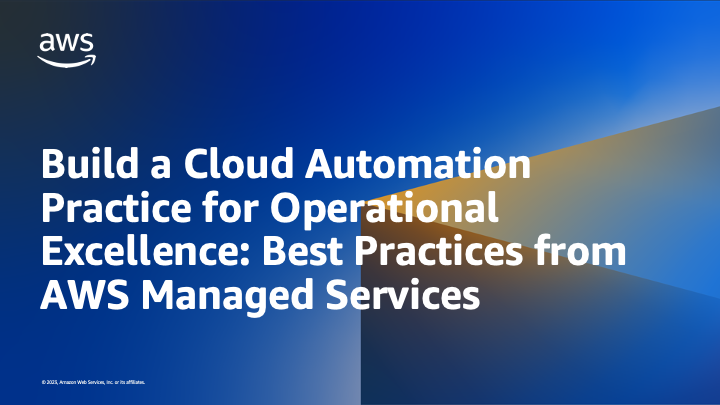
In today’s fast-paced digital landscape, businesses are under constant pressure to innovate and optimize their operations. Cloud automation has emerged as a key enabler for achieving operational excellence, offering the ability to streamline processes, reduce costs, and enhance efficiency. Amazon Web Services (AWS) Managed Services (AMS) provides a robust framework for implementing cloud automation. This blog will delve into the best practices for cloud automation as outlined by AWS Managed Services, helping your business achieve operational excellence.
Understanding AWS Managed Services
AWS Managed Services is a suite of services that automates infrastructure management tasks such as change requests, monitoring, patch management, security, and backup services. By leveraging AMS, organizations can focus more on innovation and less on routine operational tasks. The service is designed to meet enterprise needs, offering enhanced security, compliance, and reliability.
Best Practices for Cloud Automation
Automated Incident Management
One of the cornerstones of operational excellence is effective incident management. AWS Managed Services provides automated incident management through predefined runbooks. These runbooks can automatically resolve common issues without human intervention, reducing downtime and improving service reliability. Best practices include:
Implementing Self-Healing Systems: Set up automated recovery procedures for common failure scenarios. This can include restarting failed instances or automatically scaling resources in response to high demand.
Continuous Monitoring and Alerts: Utilize AWS CloudWatch to continuously monitor your systems and trigger alerts for any anomalies. Automated alerts ensure that your team is promptly informed of any issues that require manual intervention.
Automated Change Management
Managing changes in a cloud environment can be complex and risky if not handled properly. AMS provides automated change management processes that help in deploying updates and modifications efficiently and safely. Best practices include:
Version Control: Use version control systems like AWS CodeCommit to manage changes to your infrastructure and application code. This allows for easy rollback in case of issues.
Blue-Green Deployments: Implement blue-green deployment strategies to minimize downtime and reduce the risk associated with deploying new versions. This involves maintaining two identical production environments and gradually shifting traffic from the old environment to the new one.
Automated Compliance and Security
Ensuring compliance and security in a cloud environment is crucial. AMS offers automated compliance checks and security management to help organizations meet industry standards and regulations. Best practices include:
Automated Compliance Audits: Utilize AWS Config and AWS Security Hub to continuously monitor and assess your AWS resources against best practices and compliance standards. This ensures that your infrastructure remains secure and compliant at all times.
Infrastructure as Code (IaC): Use IaC tools like AWS CloudFormation to define and provision your infrastructure. This not only ensures consistency and repeatability but also allows for automated security checks and compliance validations during the deployment process.
Automated Backup and Disaster Recovery
Data loss can have catastrophic consequences for any business. AMS provides automated backup and disaster recovery solutions to protect your data. Best practices include:
Automated Backups: Configure AWS Backup to automate the backup process for your resources, ensuring that your data is regularly backed up without manual intervention.
Disaster Recovery Drills: Regularly conduct disaster recovery drills using AWS Elastic Disaster Recovery to test your recovery procedures. This ensures that your team is prepared and your systems are resilient in case of a real disaster.
Cost Optimization
Optimizing costs is a key aspect of operational excellence. AWS Managed Services offers tools and practices to manage and reduce your cloud spending. Best practices include:
Automated Cost Monitoring: Use AWS Cost Explorer and AWS Budgets to monitor and manage your cloud expenses. Set up automated alerts to notify you of any unexpected cost spikes.
Resource Optimization: Implement AWS Trusted Advisor to continuously analyze your AWS environment and provide recommendations for cost savings, such as identifying underutilized resources or recommending reserved instances.
Conclusion
Achieving operational excellence through cloud automation requires a strategic approach and the right set of tools and practices. AWS Managed Services provides a comprehensive framework for automating infrastructure management tasks, ensuring security, compliance, and cost optimization. By following the best practices outlined above, your organization can leverage the power of cloud automation to streamline operations, enhance efficiency, and drive innovation.
Incorporating these best practices into your cloud strategy not only helps in achieving operational excellence but also positions your business for sustainable growth and success in the digital age.
